Issigonis was charged with making a suitable competitor. In predictable fashion he came up with the unpredictable: the Mini, a practical answer that became acceptable transport for everyone, rich or poor.
A similar set of circumstances were to spawn the original Morris Minor, for in 1927 the Government, after a lapse of six years, reintroduced a tax on petrol (the cads!) and it was this that boosted demand for a really economical car. The light car, as it came to be known, came of age. I say "came of age" advisedly, for indeed Austin had been producing their Seven with more than a degree of success since as early as 1922.
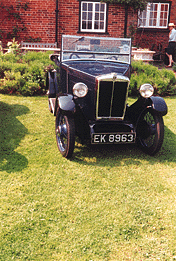 |
| 1932 Morris Minor four-seat Tourer complete with dicky seat, giving in practice, a 2+2 configuration. |
Birth of the Morris Minor Indeed, the nomenclature Seven was already becoming entrenched in the language for "The Motor" named its article of 29th May 1929 "Some Details of the new 7 hp Morris"...ven though that car was clearly an eight. The magazine felt that the car¹s overhead camshaft engine derived from the Wolseley Six was "coarse running" but would tackle in top hills that reduced the Oxford to second gear.
The Morris Minor (there was also a Morris Major of some 2 litre capacity) was introduced at the 1928 Motor Show at Olympic. It featured an 847cc engine with 57mm bore x 83mm stroke, an SU carburettor and a vertically-mounted dynamo driven off the camshaft via bevel gears. There were 19 inch wheels and performance figures of 45 mpg, 50 mph and all of 20 bhp. Body styles available included a saloon, fabric saloon, 4 seat tourer, two-seat sports,four-door family saloon and a sports coupé. The saloon was priced at £135, the tourer at £125 and you could have a bare chassis for £100.
Nuffield's recent acquisition of Wolseley not only provided the production capacity for the new model but gave the inspiration for its engine: effectively two thirds of the Wolseley Hornet¹s six cylinder layout. Alongside the Minor the MG Midget was launched, based on the same running gear but with lightened body and suitably tuned to deliver a heady 60 mph, 27 bhp and 38 mpg!
By 1930 the Minor range had been consolidated to a fabric saloon, four-seat tourer, a steel-panelled saloon with folding head and a 5 cwt van, some of which found their way into service with the Post Office, thereby starting what was to become a long-lasting trend.
But in 1931 came a seemingly retrograde step: a lower specification model Minor with a sidevalve engine. William Morris' thinking behind this was to allow the open two-seater model to sell for the magical sum of £100, something that Ford were quick to follow with their Model Y.
By 1932 "Eddyfree" streamlined styling had come to pass...effectively, the roof peak above the screen had disappeared. More practically, you could now have a four-speed synchromesh gearbox on all but the £100 model, plus hydraulic brakes and dampers, this trend persisting until 1934. A total of 86,318 Minors were produced, including light commercials, over this period.
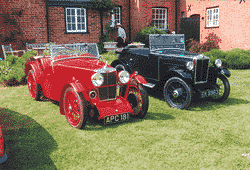 |
| An MG J2 which, together with the M Type, shares a commonality of parts with the pre-war Morris Minor alongside. |
Enter the Ford Eight While Morris were doing battle with the Austin Seven, over in the States Ford were intent on challenging the complacent British market. They could see the importance of the 8 hp market segment and went for it wholeheartedly by introducing a scaled-down big-Yank featuring the simplicity and style which have since become their benchmarks.
For a start there were but two body styles: a Tudor (two-door) and a Fordor. The 933cc engine was simple yet efficient turning in nearly 60 mph. You got a three-speed synchro gearbox and the springs were derived from the old gas-buggies, mere transverse leaves. Introduced in 1932, three years later, the Model Y had itself been pared to the magic £100. It was this car that was to become the seminal influence on the new Morris' development.
Morris Fights Back By now Leonard Lord had joined Morris and it was under his influence that the new Morris Eight came to be. The Model Y wasclearly the starting point for the new design: the two cars look very similar and the engines are almost identical, though the Morris variant is a tad smaller at 918cc. However, to stand still is to go backwards and it would have been foolhardy to continue with adesign already several years old.
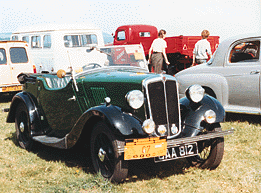 |
| 1932 Morris Eight four-seat Tourer pictured at a rally at Talygarn in the 1980s. The plate on the bumper relates to a previous European tour and demonstrates the enthusiasm of its owner to actually USE the car, rather than just take it to rallies. |
Morris therefore set about improving every element of the design, from the 3-bearing crank engine plus 3-speed box, through the suspension and easiclean wheels to sturdier bodywork all in all producing a rather better car in the process. Pre-Series cars had a central instrument panel with a rotating strip speedometer. There was two-tone paint and four body styles: two or four door saloons and two seat or four seat tourers. Series I 8s were "8s", not "Eights", and had Hardy Spicer couplings in lieu of the previously precarious fabric arrangement. By the time the Series II cars arrived in 1938 there were painted grille surrounds, easiclean wheels and single colour schemes, albeit all over black wings and running boards, continuing the two-tone appearance.
The cars were robust, reliable, economical, and of a simple design that was easy to work on. Little wonder that many badly-maintained examples struggled on manfully into the fifties and early sixties as cheap transport for many an impoverished student. All together 218,100 variants were produced, again including LCVs.
Series E In 1938 the Series E Morris 8 arrived, with radical new styling, waterfall grille and headlamps flaired into front wings. There was a rear-hinged "alligator" bonnet and while the running boards had gone, a proper boot had arrived in lieu of the fold-down luggage-carrier of the earlier cars. Under the skin, however, it was much as before, simple and reliable. The separate chassis and sidevalve engine were retained, but you could now have a four-speed synchromesh gearbox.
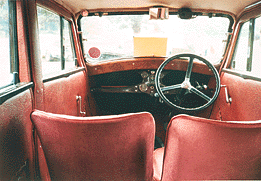 |
| Interior of a Pre-Series Morris 8 four-door saloon. Note the single wiper. Also the auxiliary mirror top left of the windscreen. |
Although undoubtedly stylish the headlights were as effective as rather bored glow-worms and many cars will now have been converted with Lucas "bug-eye" pods, which quickly became a popular option.
The Series E 4 door saloon cost £145 when introduced. There was also a 2 door, plus the 2 and 4 seat tourers, as previously with the Series IIs. But when production resumed after the War, the range was rationalised to saloons only, sadly.
Alongside Series E car production was the LCV equivalent, the Z Van. With less exuberant, plain, metal grilles and charming cabinet door handles, these soldiered on for many years as the staple Post Office and Telephones vans that preceded their Minor equivalent. Many will be familiar with the Dinky model, if not the real thing.
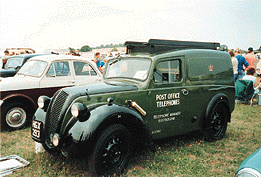 |
One of the very few surviving Morris Z Vans in Post Office Telephones livery, pictured at a rally in 1990. |
The rest of the story you probably know: how Lord Nuffield resisted the introduction of the new Minor, keeping the Series E cars in production for nearly two years longer than was intended, and how when the new car did arrive, it was to have the E's old sidevalve engine instead of the flat-fourdesigned for it.
Impressions of These Cars Today What are these old cars like to own and drive today? Well, the Morris Eight, in any of its derivatives, is probably the ideal introduction to pre-war motoring. It is simple to restore, service and maintain, charming in character and easy to drive. If you really wish to compare it with the obvious rival, the Morris has rather more space inside and is cheaper to buy, if slightly less charismatic.
The most desirable (and therefore most expensive) is the 2-seat Tourer. More practical (and rather cheaper) comes the 4-seat Tourer, with the saloons most affordable of all.
The Series E is of rather more complex construction and so is more difficult to restore, but the cheeky, friendly shape has many admirers, so really it's what appeals to the individual that counts.
Spares for Eights are relatively plentiful, thanks to the excellent club, the Morris Register, whose members are friendly, enthusiastic and helpful.
The Register caters also for the early Minors, whose owners are equally enthusiastic, it has to be said. These cars are of similar, simple construction and may be easily restored, given that spares are rather less plentiful than for their later brethren, many having been sacrificed in the restoration of the more desirable M Type Midget, with which it shares some commonality.
Whichever model you choose you will find affordable and easy to live with and a fitting garage companion to your Issigonis-designed Minor!

